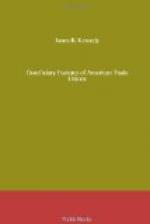[Footnote 206: Constitution, 1904 (Chicago, n.d.), pp. 52-53.]
[Footnote 207: Constitution, 1906 (New York, n.d.), pp. 15-16.]
[Footnote 208: Constitution, 1902, Art. 11.]
The only two American trade unions which in 1908 are actually paying a superannuation benefit as distinguished from a mere compounding of the death benefit are the Granite Cutters and the Typographical Union. In both the establishment of the benefit is very recent.
In 1905 the Granite Cutters made provision for the payment of a monthly benefit of ten dollars for “six months each year beginning with November” to those who had been members for twenty years and who had reached the age of sixty-two. The applicants must have been in continuous good standing for the “last ten years previous to arriving at the age of sixty-two."[209] The first payments under the new rule were made in December, 1905.
[Footnote 209: Constitution, 1905 (Quincy, n.d.), p. 45.]
The Typographical Union has, however, led all the American trade unions in the provision which it has made for its aged members. As has been noted above, as early as 1857 it was proposed to establish a home for aged printers in Philadelphia, and the project was revived from time to time. The persistence with which this proposal appeared and reappeared gave evidence of its popularity. In 1870 a Kansas union proposed the establishment of a “Home for Disabled Printers.” All members of local unions were to be taxed two dollars each for the purpose of endowing the Home. The committee of the International Union to whom the plan was referred reported that they “deemed it impracticable at the present time.” In 1877 a similar proposal was defeated. In 1882 a committee consisting of the officers of the union was appointed to inquire into the possibility of establishing and maintaining a “Home for Disabled Printers.” This committee expressed its approval of the project, but doubted the ability of the union to finance it.
In 1886 Messrs. George W. Childs and A.J. Drexel of Philadelphia presented to the International Union the sum of ten thousand dollars. This donation was to be used in any manner the union might see fit. For some years an active discussion as to the best use to be made of the fund was carried on, and in the meantime the sum was being increased by contributions from members of the union.




